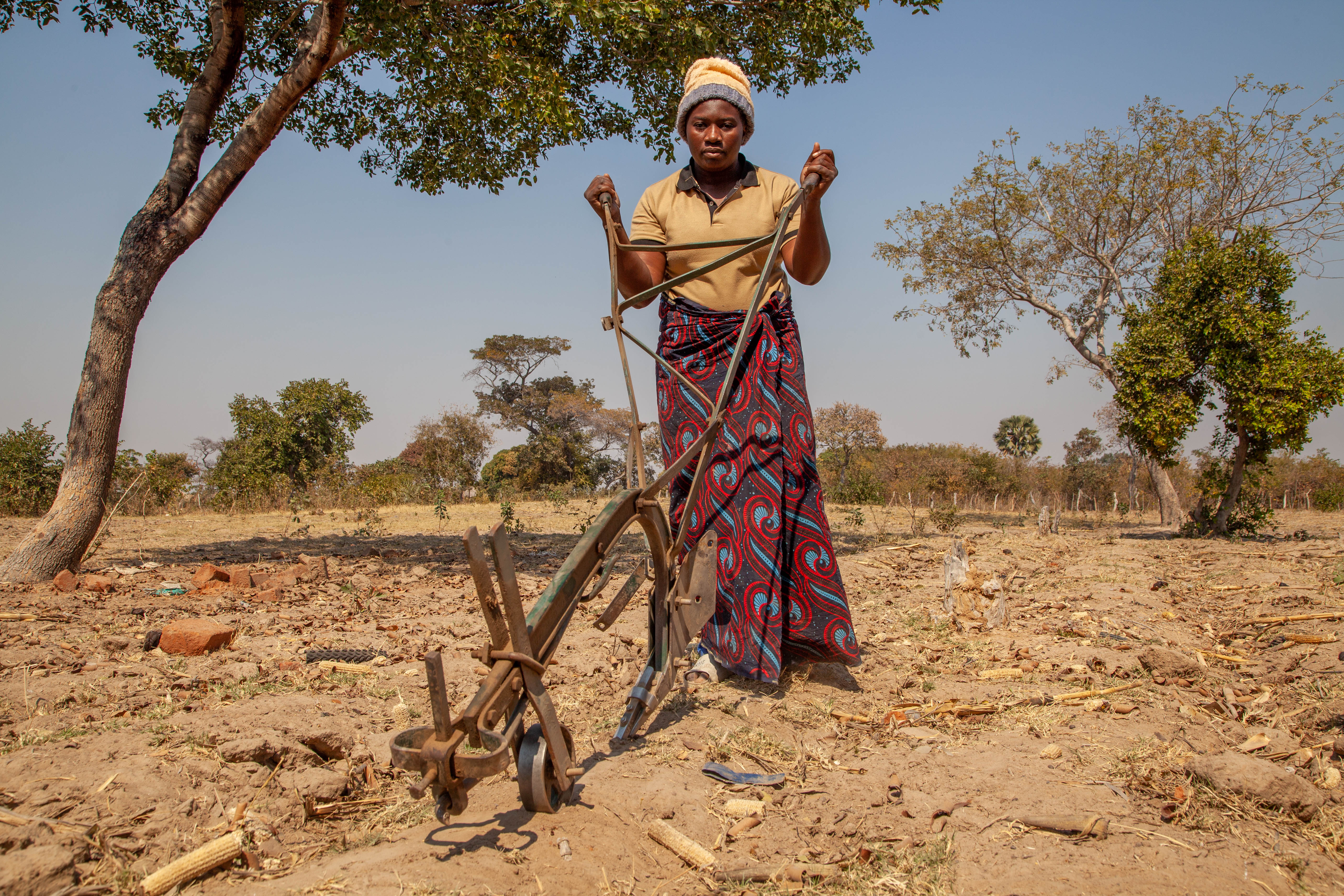A Smallholder Farmer's Success with Conservation Agriculture under the GCF/MoA Financed SCRALA project.

Brilliant Chivunga, a smallholder farmer from Namwala district who practices Conservation Agriculture.
After a journey of over 300 kilometers, we finally arrived at Brilliant Chivunga’s home in Namwala District. Chivunga is a participant in the Strengthening Climate Resilience of Agricultural Livelihoods in Agro-Ecological Regions I and II (SCRALA) project, an initiative focused on strengthening climate resilience among smallholder farmers in Zambia. Her homestead mirrored the conditions of other sites we visited during the project’s monitoring visit—a landscape marked by dry grey-brown soil and withered grass, with only a few resilient trees surviving amidst the harsh climate challenges.
The terrain, though visually striking against the clear blue-grey sky, told a different story. The drought has severely impacted the once-fertile soil, rendering it incapable of producing enough food to sustain most families. With the rain absent, hunger has become a constant threat.
Before being selected as a beneficiary of the SCRALA project, Chivunga faced significant challenges with her crop yields, which jeopardized her food security.
The impacts of climate change, particularly droughts and floods, had severely damaged most of her crops in previous years. This year, the situation across the country was exacerbated by a prolonged drought that devastated agricultural lands, destroying 982,765 hectares out of an estimated 2,272,931 hectares of maize planted, leading to widespread crop failure.

One of the farmers affected by the El Nino induced drought holding his damaged maize in Chongwe district.
However, 2019 marked a turning point for Chivunga. After being selected as a beneficiary of the SCRALA project, she received training in Conservation Agriculture, which greatly enhanced her understanding of sustainable farming practices. Additionally, she gained valuable knowledge from a local company, further supporting her efforts to adapt and thrive in the face of these ongoing climate challenges.
“The training from the project provided us with important information and knowledge which changed our approach to farming and led to remarkable crop yields."Brilliant Chivunga
Starting with plant basins on one hectare, she quickly saw improved harvests compared to traditional ploughing methods.
Conservation agriculture methods are pivotal in maintaining soil moisture, ensuring that her plants have water even during periods of dry spells. These practices enhance soil structure, safeguarding it from erosion and nutrient depletion, thereby improving crop yields even in drought conditions and promoting a better ecosystem.
She later adopted a method called ‘ripping’ on one hectare of her farmland using essential farming tools provided by the project, including a ripper, sprayer, and herbicides.
The ripped areas effectively absorb fertilizer, and applying base fertilizer before planting helps maintain soil quality for future seasons. Using rip lines also simplifies lime application, neutralizing soil acidity and fostering deep-rooted maize that stands strong even in adverse conditions.
“After we adopted these farming practices, the results were really good. We harvested 75 bags of maize, each weighing 50 kg, from one hectare during the 2023/2024 farming season–surpassing the Ministry of Agriculture's estimated 3.5 tonnes per hectare. I do not worry about what my children will eat because we have enough food such as maize throughout the year in addition to other crops that I grow such as groundnuts and cowpeas. This year, I had more than enough maize crop that I shared with my extended family members whose yields were greatly impacted by this drought crisis.”Brilliant Chivunga

Brilliant Chivunga holding the maize she harvested using Conservation Agriculture practices from the 2023/2024 farming season that was characterised by drought.

Brilliant Chivunga in her farm field holding a ripper she received from the SCRALA project.

Brilliant Chivunga standing in front of her harvested maize while holding a sprayer she received from the SCRALA project.
The maize that she grows is both for home consumption and sale, with each 50kg bag sold at K600 (USD 23), creating extra income for her household.
As a lead farmer, her household has trained 14 follower farmers who have also experienced better harvests compared to traditional farming methods.
“I am also very passionate about empowering other women in my community, and I have taken it upon myself to train them in these farming techniques,” said the 32-year-old mother of five.
In addition to her family-shared field, Chivunga manages her own, where she harvested 30 bags of maize from one lima.
Funded by the Green Climate Fund (GCF) with co-financing from the Ministry of Agriculture (MoA) and the United Nations Development Programme (UNDP), and technical support from the World Food Programme (WFP), Food and Agriculture Organisation (FAO), Zambia Meteorological Department (ZMD), and the Water Resource Management Authority (WARMA), the project supports the dissemination of these techniques through community radio stations and farmer field schools.
Conservation agriculture under the SCRALA project involves routine training conducted across all 16 targeted districts to encourage adoption and enhance food security. To date, 129,414 farmers—48% of whom are women—have been trained in these practices. This initiative equips farmers with essential climate information and weather forecasts, enabling them to make informed decisions about crop selection, optimal planting times, and effective marketing strategies, thereby supporting their efforts to improve agricultural productivity and resilience.

 Locations
Locations